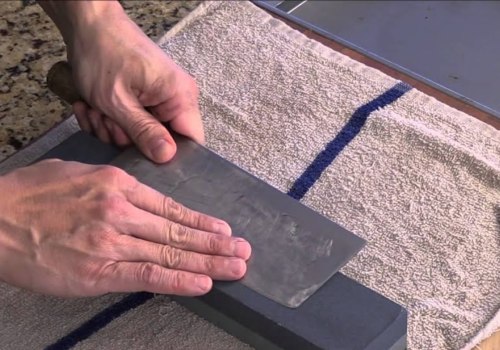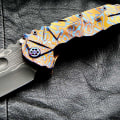Sharpening a straight edge knife is an essential skill for any chef, hunter, or outdoorsman. It takes practice and precision to get it just right, but with the right tools and techniques, you can get your knife sharp and ready for cutting in no time. In this article, we'll cover the basics of sharpening a straight edge knife, from choosing the right knife sharpening equipment to mastering the technique. Read on to learn all you need to know about sharpening a straight edge knife. Sharpening a straight edge knife is a skill that all knife owners should have.
It can help ensure that you get the most out of your knife and keep it in good condition. Knowing how to sharpen a straight edge knife properly can also help save you time and money in the long run, as you won't have to replace dull knives as often. In this article, we'll look at the different techniques and tools you can use to sharpen a straight edge knife, as well as some tips for getting the perfect edge. The first step in sharpening a straight edge knife is to choose the right sharpening angle. This is usually around 15-20 degrees, but it may vary depending on the type of knife.
You should also consider the type of stone or tool you will use to sharpen the knife. For example, if you are using a wet stone, it should be made of either silicon carbide or diamond. If you are using an electric sharpener, make sure to choose one specifically designed for straight edge knives. Once you've chosen the right sharpening angle and tool, you can start sharpening your knife. Depending on the type of tool you are using, there are different techniques you can use.
Wet stone sharpening involves running the blade over a wet stone, usually in a circular motion. Rod sharpening involves running the blade along a rod at the correct angle. Electric sharpening uses an electric grinding wheel or abrasive belt to sharpen the blade quickly and evenly. When sharpening with any of these techniques, it is important to keep the blade at the same angle throughout the process. You should also move the blade over the stone or rod evenly and with consistent pressure.
To check for sharpness, you can run your finger along the blade and feel for any resistance or dullness. If your blade is still dull after several passes, try increasing the angle slightly. In addition to sharpening techniques, proper knife maintenance is essential for keeping your knife in good condition. After each use, wipe down your knife with a clean cloth or paper towel. Avoid contact with acidic or alkaline substances, as this can cause corrosion.
You should also store your knife safely in a dry place away from extreme temperatures. Sharpening a straight edge knife correctly takes practice, but with patience and dedication, you can master this skill and get the most out of your knives. By following the right techniques and taking proper care of your knives, you can ensure that they stay sharp and ready for use.
Proper Maintenance & Care
When sharpening a straight edge knife, it is important to take proper care and maintenance into account. Common mistakes people make when sharpening their knives include using the wrong sharpening angle, applying too much pressure, and using the wrong type of sharpening stone. To avoid these mistakes, it is important to use the correct sharpening angle, which will depend on the type of knife you have.You should also apply light pressure, as too much can cause damage to the blade or make it difficult to get a nice smooth edge. Finally, make sure to choose the right type of sharpening stone, such as a diamond or ceramic stone, as each type works best with different types of knives.
Sharpening Technique Examples
Sharpening a straight edge knife requires a few different techniques and tools. The most basic of these are the sharpening stone and the honing steel. The sharpening stone is used to grind down the blade and remove metal, while the honing steel is used to realign the blade’s edge and give it a sharper, more precise edge.To sharpen a straight edge knife using a sharpening stone, it's important to use the correct angle and pressure. Start by holding the knife at a 20-degree angle against the stone, and push the blade away from you in one smooth motion. Make sure to use light pressure and keep the angle consistent as you move across the blade. After a few passes on one side, flip the knife over and repeat on the other side.
Honing steel can also be used to sharpen straight edge knives. With this technique, start by holding the honing steel at a 20-degree angle against the blade, and draw the blade along the steel in a sweeping motion. Make sure to use light pressure and keep the angle consistent throughout. It's important to use proper sharpening technique when sharpening a straight edge knife, as it helps ensure that you get the most out of your knife and keep it in good condition.
Using the wrong angle or too much pressure can damage the blade, so it's important to take your time and be mindful of your movements.
Common Mistakes to Avoid
Sharpening a straight edge knife is a skill that takes practice and patience to perfect. It's important to know the common mistakes that people make when sharpening a straight edge knife, so you can avoid them. One of the most common mistakes is not using the correct angle. When sharpening, you should use a 20-degree angle on each side of the blade.This angle will help you create a sharp and even edge on your blade. Another common mistake is not using enough pressure. When sharpening, you should use enough pressure to get the job done, but not too much. Too much pressure can lead to an uneven edge or damage to the blade.
Other mistakes include not honing the blade often enough and not using the right sharpening tool. Honing the blade is important because it removes burrs and helps keep the edge sharp. You should hone your blade regularly and use a sharpening stone or other sharpening tool specifically designed for straight edge knives. Finally, it's important to have patience when sharpening a straight edge knife. Sharpening takes time, and it's important to take your time and do it correctly.
Taking shortcuts can lead to an uneven or dull edge on your knife.
Different Sharpening Techniques
Sharpening a straight edge knife requires the right technique and tools. The most common methods are wet stone sharpening, rod sharpening, electric sharpening, and honing.Wet Stone Sharpening:
Wet stone sharpening is the most traditional way to sharpen a knife, as it has been used for centuries. It requires a whetstone, which is a flat stone, usually made from silicon carbide or aluminum oxide, with a rough and a fine side.When sharpening the knife, you move the blade against the wet stone in a circular motion.
Rod Sharpening:
Rod sharpening is another popular method of sharpening a knife. It involves using a honing rod, which is a long metal rod with a handle. You move the blade against the rod in an up-and-down motion.This method is often used to re-align the edge of the knife after it has been dulled.
Electric Sharpening:
Electric sharpening is the fastest and most efficient way to sharpen a straight edge knife. It requires an electric sharpener, which is designed to grind down the blade and realign the edge. This method is ideal for those who want to quickly sharpen their knives without too much effort.Honing:
Honing is a process that helps to maintain and refine the edge of a knife. It involves using a honing rod or steel to smooth out any imperfections in the blade's edge.This helps to keep your knife sharper for longer and prevents it from becoming dull quickly.
Choosing the Right Sharpening Angle
When it comes to sharpening a straight edge knife, choosing the right sharpening angle is essential. This angle will determine how sharp your knife becomes and how long it will stay sharp. The most common angles for sharpening a straight edge knife are 17°, 20°, and 25°. A 17° angle is the most popular option, as it produces a sharp edge that is also fairly durable.A 20° angle can create a sharper edge but is more prone to becoming dull faster. A 25° angle is the sharpest option, but it is also the least durable. To choose the right sharpening angle, you'll need to consider what type of knife you're sharpening, what type of edge you're looking for, and how often you plan to use your knife. For everyday use, a 17° angle is usually ideal. If you're looking for a razor-sharp edge for special occasions, then a 20° or 25° angle might be better. The type of stone or tool you use to sharpen your knife will also play an important role in achieving the right angle.
Generally speaking, water stones are great for creating a consistent and precise sharpening angle. For those with limited time or experience, electric sharpeners are an easy-to-use option that can provide consistent results. It's important to note that electric sharpeners can't always create the same precision as a water stone. Once you've chosen the right sharpening angle and tool, it's time to test for sharpness. To do this, simply drag the blade across your skin.
If it glides smoothly without any pulling or tugging, then you know you've achieved the desired sharpness. If it feels rough or catches on your skin, then you'll need to adjust your sharpening angle. In conclusion, sharpening a straight edge knife is an important skill that all knife owners should have. With the right tools and techniques, you can get the perfect edge, while avoiding common mistakes and ensuring proper maintenance and care. Practicing these techniques regularly will ensure that your knives stay in top condition and help you save time and money in the long run.







Leave Reply